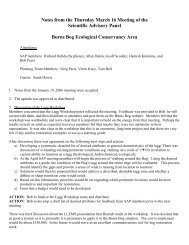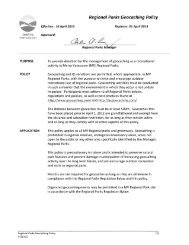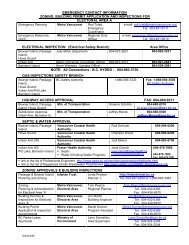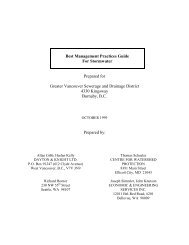Chlorine Monitoring and Dechlorination Techniques Handbook
Chlorine Monitoring and Dechlorination Techniques Handbook
Chlorine Monitoring and Dechlorination Techniques Handbook
You also want an ePaper? Increase the reach of your titles
YUMPU automatically turns print PDFs into web optimized ePapers that Google loves.
<strong>Chlorine</strong> <strong>Monitoring</strong> <strong>and</strong> Dechlorinating <strong>Techniques</strong> H<strong>and</strong>book<br />
The approach used by GVWD staff for dechlorination in an emergency situation is to use the<br />
solid form of anhydrous sodium thiosulphate. This agent is put into fibre mesh bags, which<br />
are then placed in the flow path of the released water. Therefore, a number of bags should<br />
be readily available. Rope is included in the equipment list as often the bags need to be tied<br />
in place. Personal safety equipment is also required.<br />
It is important to have Material Safety Data Sheets (MSDS) on the site for both the<br />
dechlorinating agent <strong>and</strong> for the chlorine testing kit. If there is contact with either of these<br />
agents, the MSDS provides information pertaining to treatment, if required. The MSDS will<br />
also indicate the exact personal protection equipment (PPE) that should be worn by workers<br />
who are in contact with the chemicals.<br />
Planned Situation<br />
In a planned release, the equipment <strong>and</strong> supplies will be different from an emergency<br />
response as the liquid form of the dechlorinating agent can be used.<br />
Sufficient dechlorinating agent should be delivered to the site prior to the beginning of any<br />
planned operation. Excess dechlorinating agent should be available at all times. Since it may<br />
not be available from the suppliers on short notice.<br />
Table 3-2 indicates typical supplies that should be kept on site for a planned response.<br />
3.2.2 Step 2 - Notify Authorities <strong>and</strong> Record Activities<br />
In an emergency situation, it is important to notify the correct authorities immediately upon<br />
learning of an unplanned release of chlorinated water. Notify the authorities with jurisdiction<br />
in the vicinity of the release. For instance, if a City of Vancouver water main broke in<br />
Vancouver, the City would have jurisdiction <strong>and</strong> has a designated reporting number for water<br />
main breaks. Alternatively, if a water main operated by the GVWD broke, the GVWD should<br />
be contacted. Exact procedures for contacting authorities should be pre-planned by all<br />
municipalities, <strong>and</strong> the GVWD. An Emergency Call Report Form, as outlined in the Generic<br />
Environmental Emergency Response Plan for Chlorinated Water (GVRD 1997), should be<br />
filled out to record all persons <strong>and</strong> agencies notified.<br />
In the event of a large spill, the Provincial Emergency Program (PEP) should be contacted.<br />
Although, they will likely refer the call to the Department of Fisheries <strong>and</strong> Oceans, this<br />
agency should also be contacted directly.<br />
Page 14

















